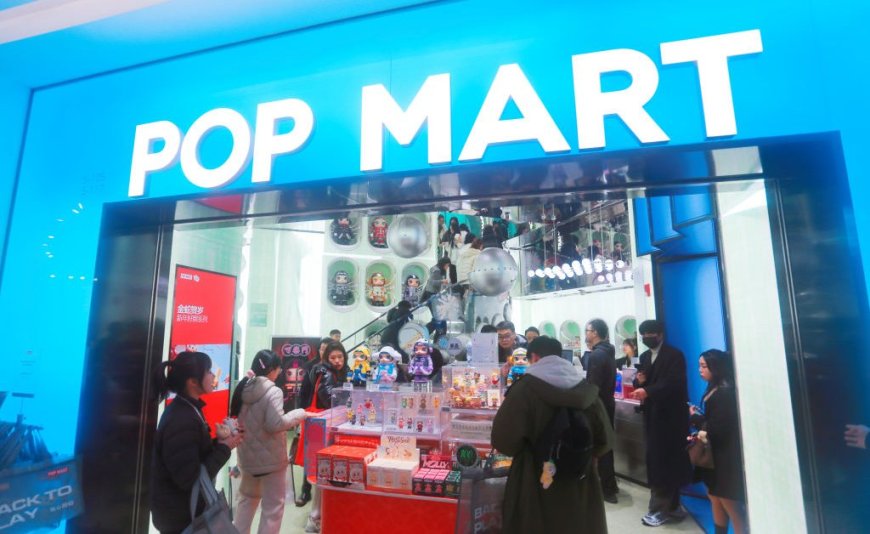How Chinese Toy Company Pop Mart Is Taking Over the World
A Shanghai-based maker of “blind box” figurines made $1.8 billion last year—and continues to grow across the world.


For years, products stamped with a “Made in China” label have been associated with kitschiness, mass production, and poor quality, in part because global demand for cheap generic products turned China into a factory for the world.
But for Claire Carrillo, one Chinese branded product is worth travelling distances, waiting hours in lines, and breaking open her wallet for. [time-brightcove not-tgx=”true”]
“It’s something that makes me happy, like it’s a treat to myself,” the 24-year-old digital marketing consultant from the Philippines tells TIME of Pop Mart’s CryBaby toy—a plush genderless creature with puffy red cheeks, furrowed brows, and welled-up tears around its eyes.
Since discovering Chinese toy company Pop Mart a year ago, Carrillo has bought nearly 100 of its products, many of which she gives as gifts to friends and family. Her love for the brand has sent her on a hunt for its characters, including travelling to Singapore for just 24 hours in hopes of finding a limited edition or waiting four hours in the rain in Taiwan just to come away with one collectible.
And Carrillo isn’t alone. A search of “Pop Mart” on TikTok renders hundreds of thousands of hauls and unboxing videos. Fans have flocked overseas to look for sold out or exclusive products at different Pop Mart stores, roboshops (vending machines), or pop-ups; and groups on Facebook and WeChat trade updates on when the brand comes out with new lines or restocks its products.
That virality has translated into a recent boom for the company, which was founded by 38-year-old entrepreneur and now-billionaire Wang Ning in 2010: last year its shares shot up by almost 370%, ahead of most members on the MSCI China Index. In mainland China alone, Pop Mart has over 46 million members, consumers who sign up to collect points for purchases, as of December 2024, and even opened Pop Land, an amusement park spanning 40,000 square meters in Beijing, in September 2023.
But it’s outside China where Pop Mart is really taking off. Over 130 of the company’s more than 530 stores worldwide as well as over 190 of more than 2,490 roboshops, as of December 2024, are located outside mainland China, and its non-mainland revenue grew by 375% to 5 billion yuan (about $700 million) in 2024, accounting for nearly 40% of its approximately $1.8 billion total revenue, according to the company’s 2024 annual report, which was released on Wednesday.
Some might say Pop Mart is riding a wave. One could argue, however, that it is making the wave. While the rest of China’s economy slowed and youth unemployment spiked last year, its guzi—goods, specifically character-based merchandise and collectible toys—market continued to soar, with Pop Mart leading the way. China’s designer toy industry is projected to reach more than 110 billion yuan, or US$15 billion, in retail sales in 2026—more than 1500% increase from 2015, when retail sales were just US$890 million. Worldwide, the toy and figurine market is projected to reach a market value of $49 billion by 2034, up from $26 billion last year.
“I go Pop Mart everywhere,” Lisa, the mega famous Thai actress-singer and member of K-pop group Blackpink, told Vanity Fair in a “my secret obsession” video in November. “If I fly to New York, I go to Miami, I try to find Pop Mart there, Paris, you know, everywhere. Kind of like a treasure, finding treasure.”
Here’s what to know about how Pop Mart took over the world.
Redefining luxury for a new generation of consumer
Where Pop Mart distinguishes itself from both domestic and international competitors is in reading the mood of its consumers, Ashley Dudarenok, who runs a China and Hong Kong-based consumer research consultancy, tells TIME. Whether it’s rebelliousness, a desire to escape, or exhaustion from work or school, Pop Mart customers are buying more than just a toy, they’re buying a symbol of themselves.
They’re often essentially useless, says scholar Erica Kanesaka, an assistant professor of English at Emory University specializing in the politics of cuteness in Asian American literature, but they “add a sense of vibrancy and imagination to our mundane activities and environments.”

Relatability seems to be a big part of cultivating fandoms for different characters. Carillo says she is drawn to the CryBaby series because she thinks of herself as a cry baby. Ashley Jane Leow, a 25-year-old filmmaker in Singapore, collects figurines of Hirono, an angsty-looking boy with tousled hair, and Nyota, an introverted girl with wide eyes and short bangs, because they remind her of herself and her boyfriend. “It got so bad that I was dreaming about it at one point,” Leow tells TIME.
Pop Mart’s strengths fit into a broader client-centric marketing model several Chinese brands have begun to adopt that incorporates client psychology and storytelling. “What truly matters is how a brand makes clients feel,” luxury brand strategy expert Daniel Langer wrote in Jing Daily last August.
Creating a following for a brand typically used to rely on products being a status symbol, such as designer handbags. But the proliferation of cheaper “dupes” made easily available on Amazon, TikTok Shop, and Shein have taken some of the allure away from such products.
Increasingly, Langer observed, many of the rising Chinese luxury brands that are now excelling globally have moved away from a traditional 4P model (Product, Price, Place, Promotion) to a 4E model (Experience, Exclusivity, Engagement, and Emotion). While Pop Mart doesn’t market itself as a luxury brand, it resembles one for a new generation of consumers, and its prices range from US$5 for a small accessory to more than US$1,500 for a 30-inch figurine, while it’s even made a foray into jewellery.
Capitalizing on artist individuality—and IP
To stand out in an international market, Pop Mart is pushing art and innovation to the forefront of its public image, Eva Zhao, the head of international marketing at Pop Mart, tells TIME. By platforming its individual designers and artists hailing from around the world, the company creates a sense of individuality in its products, a far cry from the stereotypes of mass production and copycat products often applied to Chinese brands. That also means it can partner with legacy brands that would otherwise be competitors, like Disney and Sanrio, for toys of their characters in Pop Mart’s unique style and with artists in different countries whose art might have wider appeal to customers overseas, Zhao said.
Labubu, a Nordic monkey-like forest elf with a devilish grin designed by Netherlands-based artist Kasing Lung, went viral outside of China last year for being “ugly-cute”—but it isn’t Pop Mart’s most popular character in mainland China (that’s Molly, a little girl with cat-like emerald eyes and a distinct pout designed by Hong Kong-based artist Kenny Wong). Instead, Labubu is Pop Mart’s bestselling IP globally—in part fueled by Lisa, who posted an Instagram story to her more than 100 million followers last April hugging a giant Labubu plush toy and with a Labubu bag charm. In 2024, The Monsters IP (which includes Labubu) generated 3 billion yuan (US$419 million) in revenue—a year-on-year growth of 726.6% in related revenue, according to the annual report.

Pop Mart shares the biographies of its artists on its website or social media and posts background stories and additional content for characters to try to foster deeper connection with consumers. For example, Los-Angeles based artist Libby Frame who designed Pop Mart’s Peach Riot, a punky fictional three-member girl band, also creates songs for the band.
The emphasis on the artists behind each character resonates with Leow. On a visit to the Pop Mart store in Taipei, Leow was struck by the fact that an entire floor had been turned into an exhibition of the art behind one of Pop Mart’s figurines, Pucky—a stubby, chubby sprite named after Puck from Shakespeare’s A Midsummer Night’s Dream. “I was like, you know what?,” recounts Leow, “Support an artist, I see the vision, so I bought it.”
Breaking into the global ‘cute’ market
While Pop Mart sells large busts, figurines, and accessories, their toys most commonly come in a “blind box” format. Pop Mart’s blind boxes are themed by character and series, but similar to Gashapon machines in Japan (which churn out a surprise toy inside a capsule), exactly which toy you’ll get is a mystery when you buy it.





















































